ShUM, Jerusalem on the Rhine: Speyer, Worms, Mainz
When threats of destruction to property and life follow and linger over a group of people through no fault of their own over centuries, there’s something to be said about an eternal need to keep a watchful eye. Words like Verfolgung, Vernichtung, and Vertreibung1 have been etched into memory. I have all this in mind as I explore Jewish history in Germany as part of my need to answer the following question:
How did a nation of people which fostered composers Bach, Beethoven, Handel, Mendelssohn-Bartholdy, Strauss; and writers Goethe, the Brothers Grimm, Heine, Hesse, Heinrich and Thomas Mann, and Schiller sink to the worst depths of human atrocity and depravity in the first half of the 20th-century?
It’s easy to forget Jewish people have lived in what is now Italy and southern Europe since the middle of the 2nd-century BCE and inhabited southern Germany from the late 10th-century AD/CE2. During the High Middle Ages, three important bishopric (and cathedral) cities of Speyer, Worms, and Mainz along the Rhine river formed an important league or federation of Jewish communities (Kehillot) from the end of the 10-century to about the mid-to-late 14th-century. The word שו”ם or ShUM (SchUM in German)4 is an acronym consisting of the first letters of the Hebrew names for the three cities:
• Shin (ש), Sh for Shpira (שפירא) → present-day Speyer;
• Waw or Vav (ו), U for Warmaisa (וורמש) → present-day Worms;
• Mem (ם), M for Magenza (מגנצא) → present-day Mainz.
The ShUM cities became centres for learning, training, religion, culture, and trade within medieval Germany (Ashkenaz3) and throughout Europe. Today, the three ShUM cities establish key destinations for historical travel, provide rich examples for continuing research on medieval Jewish life, and add up to a comprehensive project in recognizing an important chapter of the history of Jews in Germany.
The ShUM/SchUM was inscribed as World Heritage Site by UNESCO at the 44th meeting of the World Heritage Committee in July 2021. ShUM is Germany’s 1st all-Jewish world heritage site, a big acknowledgement to the centuries-long presence of the Jewish community along the Rhine river.
ShUM/SchUM league
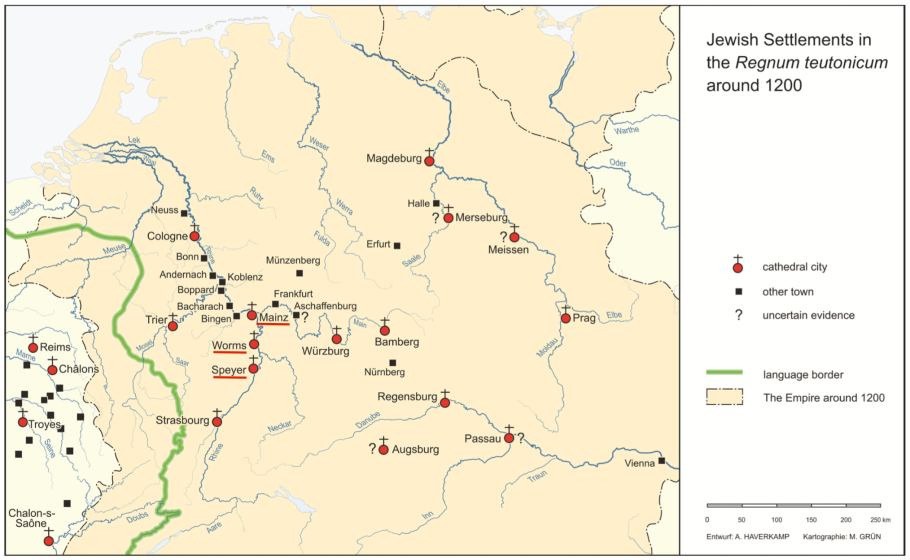
Jewish settlements in the Regnum teutonicum (Germanic/Teutonic empire) around 1200 AD/CE. I’ve underlined in red the three ShUM cities of Speyer, Worms, and Mainz; note all three are also cathedral cities. Map by A. Haverkamp & M. Grün, in “Jews in the Medieval German Kingdom”, by Alfred Haverkamp, translated by Christoph Cluse, online edition, Trier University Library, 2015.
Shpira (Speyer), ש
The Judenhof (Jewish courtyard) is home to the remnants of the city’s Synagogue, inaugurated in 1104 AD/CE and one of the oldest Jewish places of worship from the Middle Ages in Europe; the separate women’s synagogue (c. 1250); and the Mikwe (c. 1120), the oldest intact Jewish ritual baths in Europe. For people with “Shapiro” and their variants as surnames, their earliest predecessors would’ve likely originated in Speyer5.
• Speyer Tourismus, in German.
• Der Judenhof, Regional Geschichte.
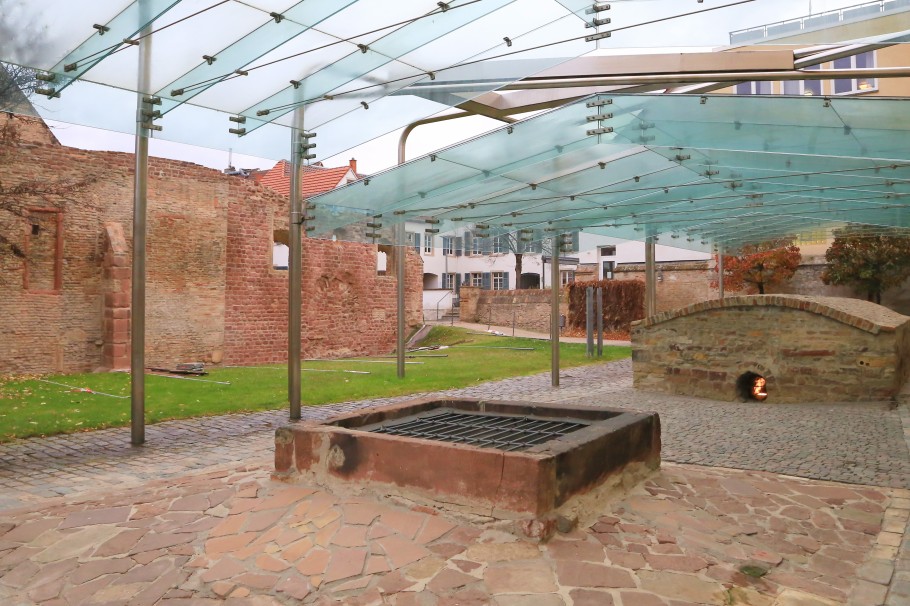
Left: Old Synagogue; centre and right: Mikwe (HL).

Parts of the Mikwe from 1110-1120 (left-to-right): abacus and capital, double-arch window, arched window, capital (HL).
Warmaiza (Worms), ו
The “little Jerusalem on the Rhine” was one of the longest continuously functioning Jewish communities in Europe, beginning about 1000 AD/CE and ending with National Socialism in the 1930s-1940s. Particularly noteworthy in the city are the synagogue (c. 1034), women’s synagogue (c. 1212), Mikwe (c. 1185), and the Jewish cemetery “Heiliger Sand” (Holy Sand), considered the oldest preserved Jewish cemetery in Europe. The oldest grave in the cemetery whose markings are still legible go back to 1058-1059.
• Worms Tourismus, in German.
• Die jüdische Gemeinde Warmaisa, Regional Geschichte.
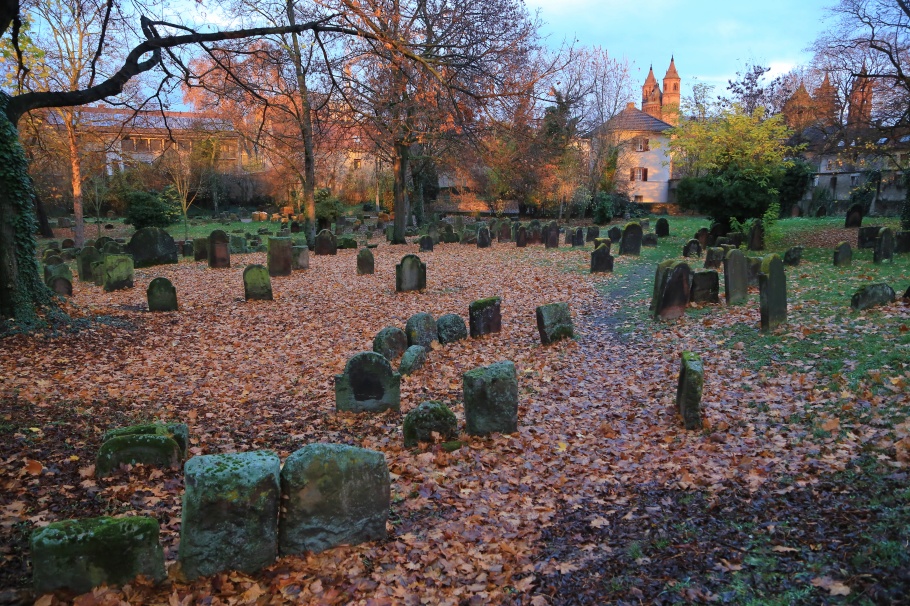
Heiliger Sand (Holy Sand); oldest grave with legible markings dated to 1058-1059 (HL).

Centre: entrance to Synagogue; right foreground: Rashi memorial sculpture (HL).
Magenza (Mainz), ם
One of the most visually striking pieces of architecture is the Jewish Community Centre and the new Synagogue. With the five Hebrew letters forming the word ‘Kedushah’ (holiness) inscribed onto the building, the new centre was inaugurated in 2010 and built at the site of the 1912 synagogue which was burned and destroyed on the Pogrom night in 1938. In the city’s cemetery, the oldest known Jewish gravestone north of the Alps was found and dated to 1049 AD/CE; the original gravestone is now a part of the Judaica collection in Landesmuseum Mainz.
• Mainz Tourism, in English.
• “Magenza, die Geschichte des jüdischen Mainz”, Regional Geschichte.
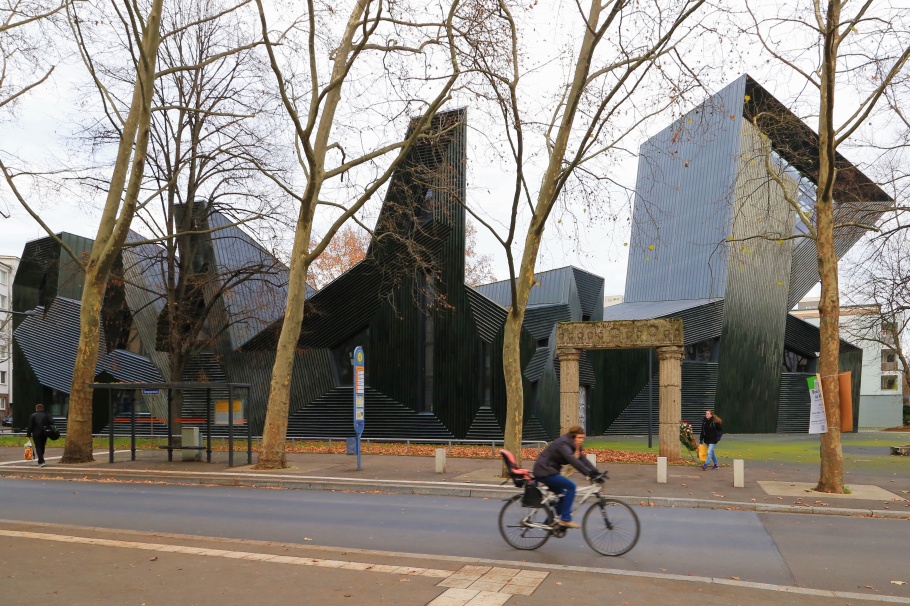
New Synagogue at Synagogenplatz (HL).
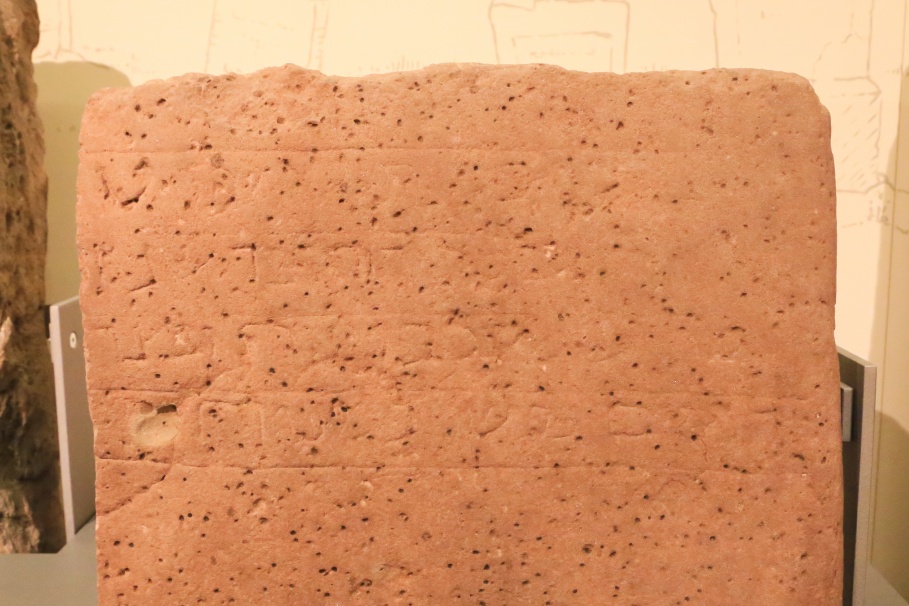
“Jehuda, son of Schneor”, dated 2 April 1049, in the Landemuseum’s Judaica collection (HL).
Travel by train
Speyer can be reached from Mannheim/Heidelberg and Karlsruhe within 25-45 and 40-60 minutes, respectively, with S-Bahn Rhein-Neckar and regional trains.
Worms can be reached from Speyer, Mannheim, and Heidelberg within 30-60, 25, and 45-60 minutes, respectively, with regional trains.
Mainz can be reached from Mannheim and Frankfurt am Main within 40-80 and 40 minutes, respectively, with regional trains and the S-Bahn Rhein-Main train (S8).
Notes & More
1 “Verfolgung”: persecution, pogrom; “Vernichtung“: extermination, annihilation; “Vertreibung”: expulsion, forced migration. All three ShUM cities encountered major and minor periods of persecution, extermination, and expulsion (to eastern Europe), including the Rhineland massacres (First Crusade) of 1096 and the Plague pogroms of 1348-1349.
2 “The Illustrated History of the Jewish People”, by Nicholas De Lange and Jane S. Gerber, Harcourt Brace (1997).
3 “Ashkenaz” (אשכנז) for “Jewish medieval Germany”; see the description here. For the present and future posts, I use “Ashkenaz” in the historical context of the area around the ShUM cities along the Rhine river in what is now the German federal state of Rhineland-Pfalz (Rhineland-Palatinate).
4 Hebrew is written and read right-to-left. “Shum” also happens to be the word for “garlic” in Hebrew.
5 See also “A Dictionary of Jewish Names and Their History”, by Benzion C. Kaganoff, Rowman and Littlefield (1996).
• ShUM-Cities Association
• “Uncovering ancient Ashkenaz”, RNS (2016).
• “The Origins of Ashkenaz”, Forward (2008).
• About the SchUM, in German with English subtitles (2019).
• Die drei Gemeinden, SchUM Städte.
• “Hoffen auf die Anerkennung als UNESCO-Welterbe”: Katrin Kühne, Deutschlandradio Kultur, 6 März 2015.
• Epigraphy and historical inscriptions of Jewish gravestones, in English and German.
• Jewish heritage on the Rhine, from DW CHECK-IN: 26-min video in English.
Thanks to Rheinland-Palatinate Tourism for advice and support in Speyer, Worms, Mainz, and Koblenz. I made all photos between 19 and 24 November 2015 inclusive. This post appears on Fotoeins Fotografie at fotoeins DOT com as http://wp.me/p1BIdT-8gj.
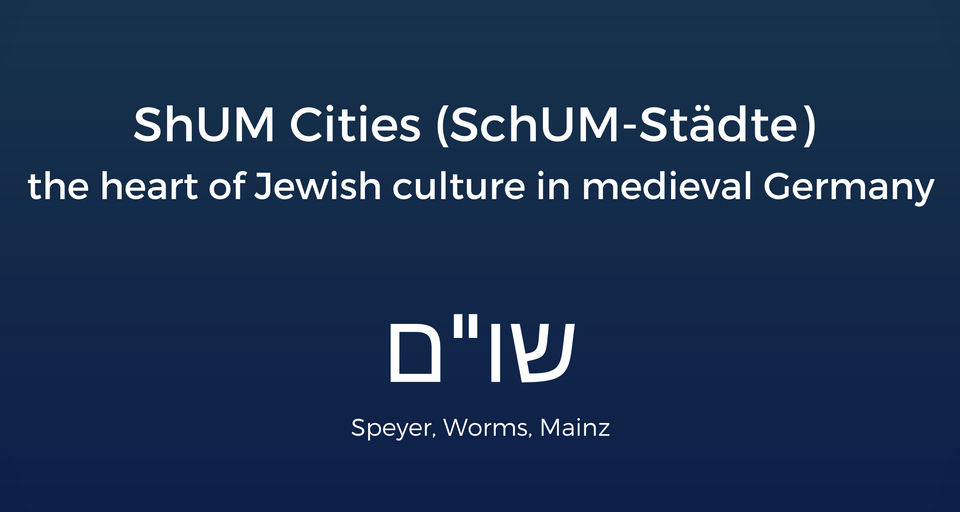
7 Responses to “ShUM, Jerusalem on the Rhine: Speyer, Worms, Mainz”
[…] The cemetery is also called “Holy Sand”1, and is one of many places of interest in the medieval ShUM league of Jewish cities. The gravestones for Rabbi Meir ben Baruch (centre) and Alexander ben Salomo (right) are shown in […]
LikeLike
Thank you for sharing this, I have been to some but not all of the places and would love to hear more..
LikeLiked by 1 person
Thanks for stopping by and for your comment, Randi. I’ll have more upcoming pieces about the ShUM cities.
LikeLike
[…] structures from the once-thriving Jewish community which along with Speyer and Mainz formed a medieval league of Jewish communities. Many will retrace Martin Luther’s steps in the […]
LikeLike
[…] Jewish cemetery, these two graves are dated between 1058 and 1077. Worms formed one part of the ShUM, a medieval federation of three Jewish towns along the Rhine […]
LikeLike
[…] cities of Speyer, Worms, and Mainz facilitated the creation of a common Jewish league with the name ShUM (SchUM), spelled out by the first letters of the Hebrew names for the three cities. To emphasize the influence of Jewish heritage in Europe and to continue the ongoing process of […]
LikeLike
[…] included the cathedral cities of Speyer, Worms, and Mainz, all located along the Rhine river. The ShUM league is named after the first letters of each city in Hebrew. As a brand new UNESCO World Heritage Site […]
LikeLike